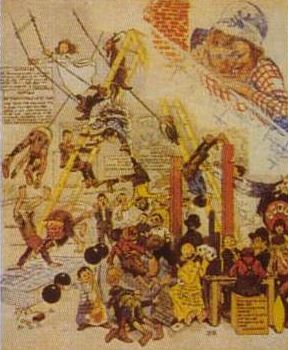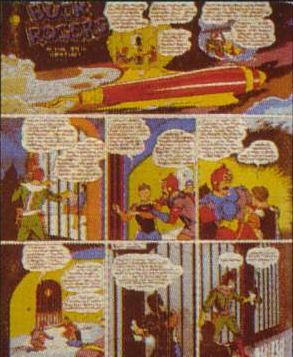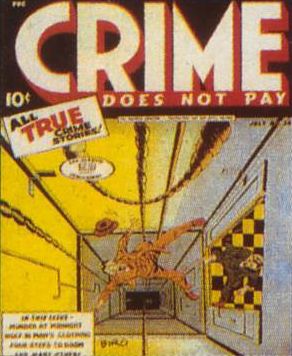A brief History of Comics
 1895 Hogan's Alley featuring a bald-headedm big-eared urchin clad in a yellow night-shirt (althougg it was orginally blue), make its first appearance in the Sunday New York. It's the first comic strip to use speech bubbles, and the Yellow kid becomes an instant hit, later graduating to his own comic strip. Hogan's Alley and its offshoots don't last long, but they're around long enought to gain recognition as the forerunners to modern comics.
1895 Hogan's Alley featuring a bald-headedm big-eared urchin clad in a yellow night-shirt (althougg it was orginally blue), make its first appearance in the Sunday New York. It's the first comic strip to use speech bubbles, and the Yellow kid becomes an instant hit, later graduating to his own comic strip. Hogan's Alley and its offshoots don't last long, but they're around long enought to gain recognition as the forerunners to modern comics.
1905 In 1905 Little Nemo in Slumberland first appeared in the New York Hearld. Centered on the dreams of a boy named Nemo, the strips were often serialised over several weeks as Nemo explored, strange dreamlands and underwent exciting nocturnal adventures, usually ending with him falling out of bed. Serialised comics took another 20 years to catch on, but Nemo was there first.
1924 Washington Tubbs 2 made its debut. Initially an ordinary soap opera-style about the life of a boy named George Washington Tubbs 2, it took a new turn a few months into its life when Tubbs went off a hunt for buried treasure. A series of exciting movie-style cliff hangers followed, and readers just kept on reading, enthralled by this new twist on the comic genre. The adventure comic had been born, and Washington Tubbs 2 was soon followed by yet more adventurists.
 1929 Sci-fi made it way into the world of comic strips, when a tale from Amazing Stories Magazine called Armageddon 2419AD was reworked for the comic format. The result was Buck Rogers in the 25th Century. Publishers soon scrambled to create their own Buck Rogers, resuling in Flash Gordon, among others.
1929 Sci-fi made it way into the world of comic strips, when a tale from Amazing Stories Magazine called Armageddon 2419AD was reworked for the comic format. The result was Buck Rogers in the 25th Century. Publishers soon scrambled to create their own Buck Rogers, resuling in Flash Gordon, among others.
1933 Eastern Color Press came with the idea of seperate comic section on a single boardsheet. This colud then be folded into the first comic book, which was full of reprinted strips and given away with the paper. Other publishers followed suit.
1938 Jerry Siegel and Joe Shusterm had been hawking their own comic strip around the newspapers for about six years. Editor laughed at a man who leap tall building with a single bound, who was faster than a speeding bullet and more powerful than a locomotive. Harry Donenfeld, National's publisher, thought that this 'Superman' had possibilities, After Superman's success, superheroes began to appear in droves.
1946 A fresh injection of ideas was needed, and this came in the form of Crime Does Not Pay, a comic featuring "ALL TRUE crime stories." Crime-based comics, full of blood, death and gore, became the flavour of the month. Comics had grown up quickly, and some people were shocked at the new direction the 'funnies' had taken.
 1953 Frederic Wertham, a psyhologist, published a book, Seduction of the Innocent, in which he accused comics of filling children's heads with images of sex and violence, and claimed that comics wrere turning kids into thieves, bullies and killers. Parents were discover that Batman and Robin were actually involved in a homosexual relationship! The ensuring hysteria led to the formation of the Comics Code Authority, and comics were forced to clean up. Publishers were forced to produce cleaner-than-clean titles to appease the CCA.
1953 Frederic Wertham, a psyhologist, published a book, Seduction of the Innocent, in which he accused comics of filling children's heads with images of sex and violence, and claimed that comics wrere turning kids into thieves, bullies and killers. Parents were discover that Batman and Robin were actually involved in a homosexual relationship! The ensuring hysteria led to the formation of the Comics Code Authority, and comics were forced to clean up. Publishers were forced to produce cleaner-than-clean titles to appease the CCA.
1961 Marvel Comics was on the brink of collapse when artist Jark Kirby turned up. The Kirby creation to revitalise Marvel was the Fantasitic Four, followed by the Incredible Hulk and Spiderman. The Kirby heroes caught on, partly due to the fact people could identify with the characters. This new twist combined with Kirby's vivid style, brought Marvel back from the dead and made it into a force to be reckoned with (back then).
1977 2000AD build upon the style of British comics, learned a few tricks from the American comics and biggest phenomenenon in British comic history. Decidely sci-fi style, it also had a much harder edge to it than the Americans, because it didn't fall under the fall under the jurisdiction of the CCA. (CCA actually banned all work of the 2000AD artist Kevin O'Neill.) At the core of 2000AD's success was, Judge Dredd, a future law-man with the power to dispense justice on the streets. The British influence on the comics industry was just beginning.
1986 In a genre that attracted the critique that it was 'just for kids', two titles appeared that brought comics into the public eye and afforded them the 'literature' label. The first was Frank Miller's Batman: The Dark Knight Returns. The second, Alan Moore and Dave Gibbons' Watchmen, was a milestone in comics history. For a while, it looked like comics were about to hit the mainstream.
 1895 Hogan's Alley featuring a bald-headedm big-eared urchin clad in a yellow night-shirt (althougg it was orginally blue), make its first appearance in the Sunday New York. It's the first comic strip to use speech bubbles, and the Yellow kid becomes an instant hit, later graduating to his own comic strip. Hogan's Alley and its offshoots don't last long, but they're around long enought to gain recognition as the forerunners to modern comics.
1895 Hogan's Alley featuring a bald-headedm big-eared urchin clad in a yellow night-shirt (althougg it was orginally blue), make its first appearance in the Sunday New York. It's the first comic strip to use speech bubbles, and the Yellow kid becomes an instant hit, later graduating to his own comic strip. Hogan's Alley and its offshoots don't last long, but they're around long enought to gain recognition as the forerunners to modern comics. 1929 Sci-fi made it way into the world of comic strips, when a tale from Amazing Stories Magazine called Armageddon 2419AD was reworked for the comic format. The result was Buck Rogers in the 25th Century. Publishers soon scrambled to create their own Buck Rogers, resuling in Flash Gordon, among others.
1929 Sci-fi made it way into the world of comic strips, when a tale from Amazing Stories Magazine called Armageddon 2419AD was reworked for the comic format. The result was Buck Rogers in the 25th Century. Publishers soon scrambled to create their own Buck Rogers, resuling in Flash Gordon, among others. 1953 Frederic Wertham, a psyhologist, published a book, Seduction of the Innocent, in which he accused comics of filling children's heads with images of sex and violence, and claimed that comics wrere turning kids into thieves, bullies and killers. Parents were discover that Batman and Robin were actually involved in a homosexual relationship! The ensuring hysteria led to the formation of the Comics Code Authority, and comics were forced to clean up. Publishers were forced to produce cleaner-than-clean titles to appease the CCA.
1953 Frederic Wertham, a psyhologist, published a book, Seduction of the Innocent, in which he accused comics of filling children's heads with images of sex and violence, and claimed that comics wrere turning kids into thieves, bullies and killers. Parents were discover that Batman and Robin were actually involved in a homosexual relationship! The ensuring hysteria led to the formation of the Comics Code Authority, and comics were forced to clean up. Publishers were forced to produce cleaner-than-clean titles to appease the CCA.